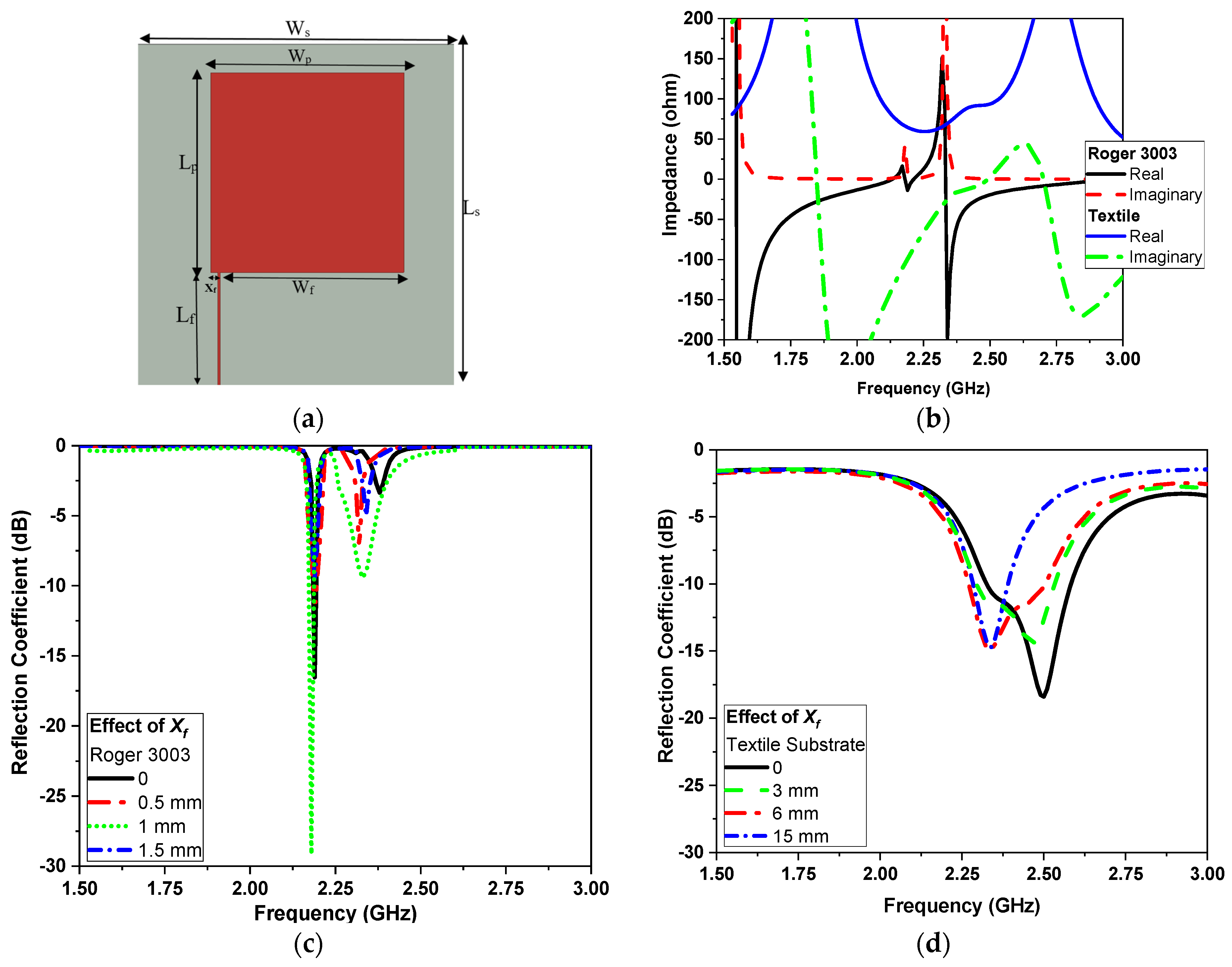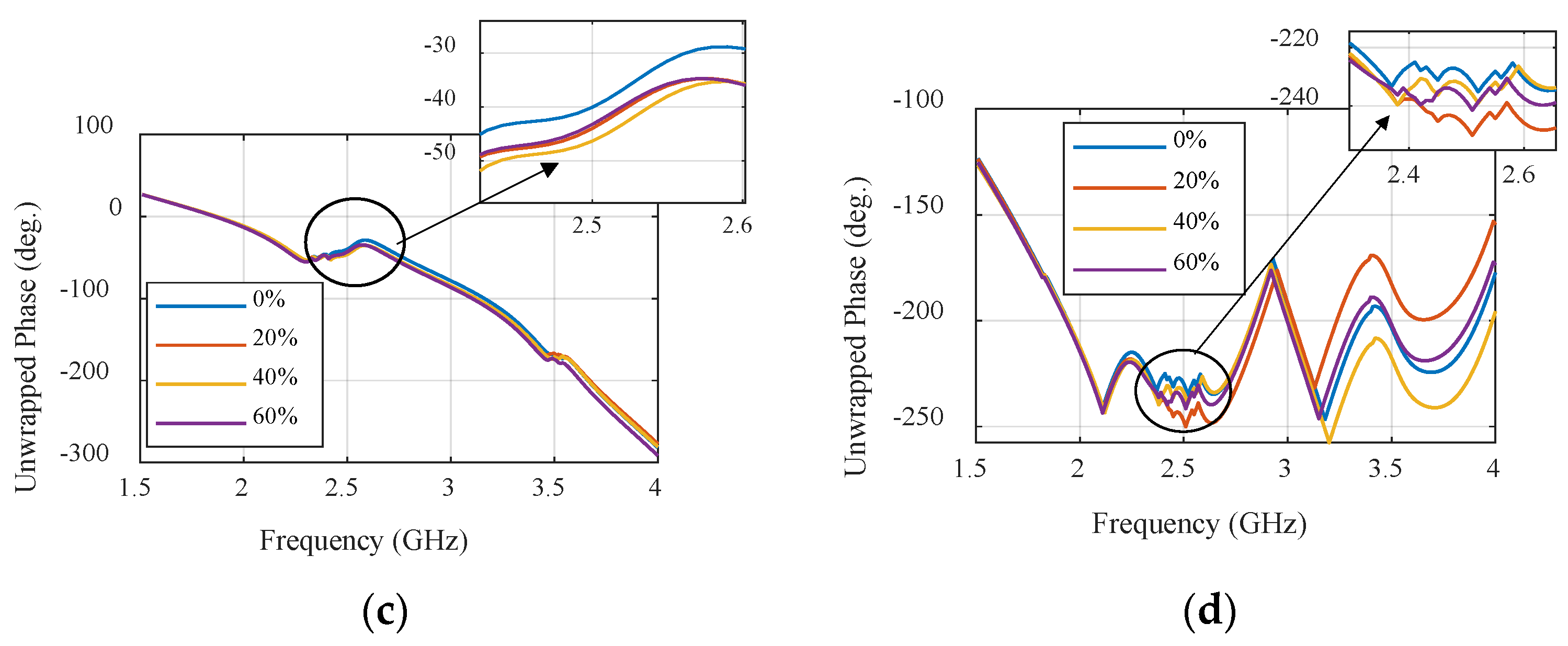Figure 1.
(a) Configuration of the offset feed transmission line microstrip sensor, (b) input impedance (real and imaginary) for both the flexible and the textile substrate and the effect of the location Xf on (c) the flexible and (d) the textile substrate.
Figure 1.
(a) Configuration of the offset feed transmission line microstrip sensor, (b) input impedance (real and imaginary) for both the flexible and the textile substrate and the effect of the location Xf on (c) the flexible and (d) the textile substrate.
Figure 2.
Photo of fabricated antenna. (a) Flexible substrate, (b) conductive fabric, (c) measurement setup, and (d) simulated and measured |S11|.
Figure 2.
Photo of fabricated antenna. (a) Flexible substrate, (b) conductive fabric, (c) measurement setup, and (d) simulated and measured |S11|.
Figure 3.
(a) Design steps, (b) simulated |S11| of design steps, (c) configuration of the UWB monopole antenna, and (d) impedance (real and imaginary).
Figure 3.
(a) Design steps, (b) simulated |S11| of design steps, (c) configuration of the UWB monopole antenna, and (d) impedance (real and imaginary).
Figure 4.
|S11| versus frequency for different parametric sweeps. (a) Effect of Lg. (b) Effect of Lgg. (c) Effect of Wgg.(d) Effect of Lk. (e) Effect of Lm.
Figure 4.
|S11| versus frequency for different parametric sweeps. (a) Effect of Lg. (b) Effect of Lgg. (c) Effect of Wgg.(d) Effect of Lk. (e) Effect of Lm.
Figure 5.
Surface current density distribution of the proposed monopole at different frequencies: (a) 2.4 GHz, (b) 3.5 GHz, (c) 5.2 GHz, (d) 6 GHz, (e) 7.5 GHz, and (f) 10 GHz.
Figure 5.
Surface current density distribution of the proposed monopole at different frequencies: (a) 2.4 GHz, (b) 3.5 GHz, (c) 5.2 GHz, (d) 6 GHz, (e) 7.5 GHz, and (f) 10 GHz.
Figure 6.
Measurement results. (a) Photo of the fabricated antenna. (b) Measurement setup. (c) Simulated and measured reflection coefficient.
Figure 6.
Measurement results. (a) Photo of the fabricated antenna. (b) Measurement setup. (c) Simulated and measured reflection coefficient.
Figure 7.
The model of a human chest with and without the phantom of the textile sensor (a) Chest phantom. (b) |S11| response.
Figure 7.
The model of a human chest with and without the phantom of the textile sensor (a) Chest phantom. (b) |S11| response.
Figure 8.
Simulation of two NB microwave sensors. (a) The 3D model. (b) Magnitude of |S11| in dB. (c) |S11| phase (red without water level, black with water level).
Figure 8.
Simulation of two NB microwave sensors. (a) The 3D model. (b) Magnitude of |S11| in dB. (c) |S11| phase (red without water level, black with water level).
Figure 9.
Simulation of the S parameter’s magnitude. (a) Reflection coefficient. (b) Transmission coefficient and phase. (c) Reflection coefficient. (d) Transmission coefficient of the NB sensor.
Figure 9.
Simulation of the S parameter’s magnitude. (a) Reflection coefficient. (b) Transmission coefficient and phase. (c) Reflection coefficient. (d) Transmission coefficient of the NB sensor.
Figure 10.
UWB microwave sensor. (a) Phantom model. (b) Reflection coefficient magnitude.
Figure 10.
UWB microwave sensor. (a) Phantom model. (b) Reflection coefficient magnitude.
Figure 11.
Simulation of two monopole antennas with a chest model. (a) The 3D model. (b) The S parameters’ magnitude in dB. (c) The S-parameters’ phase in degrees.
Figure 11.
Simulation of two monopole antennas with a chest model. (a) The 3D model. (b) The S parameters’ magnitude in dB. (c) The S-parameters’ phase in degrees.
Figure 12.
Simulation of the S parameters’ reflection coefficient (a) magnitude and (b) phase, and transmission coefficient (c) magnitude and (d) phase.
Figure 12.
Simulation of the S parameters’ reflection coefficient (a) magnitude and (b) phase, and transmission coefficient (c) magnitude and (d) phase.
Figure 13.
The proposed system. (a) Block diagram. (b) System photo. (c) Experiment setup.
Figure 13.
The proposed system. (a) Block diagram. (b) System photo. (c) Experiment setup.
Figure 14.
Proof of concept. (a) Measurement setup. (b) Breathing behavior versus time.
Figure 14.
Proof of concept. (a) Measurement setup. (b) Breathing behavior versus time.
Figure 15.
Breathing rate for the 8-year-old child using NB sensors. (a) Experiment setup. (b) Phase versus time.
Figure 15.
Breathing rate for the 8-year-old child using NB sensors. (a) Experiment setup. (b) Phase versus time.
Figure 16.
Breathing rate for the 35-year-old adult using NB sensors. (a) Experiment setup. (b) Phase versus time.
Figure 16.
Breathing rate for the 35-year-old adult using NB sensors. (a) Experiment setup. (b) Phase versus time.
Figure 17.
Breathing rate after a running activity using NB sensors. (a) Child case. (b) Adult case.
Figure 17.
Breathing rate after a running activity using NB sensors. (a) Child case. (b) Adult case.
Figure 18.
Breathing rate for the 8-year-old child in normal conditions using UWB sensors. (a) Experiment setup. (b) Phase versus time.
Figure 18.
Breathing rate for the 8-year-old child in normal conditions using UWB sensors. (a) Experiment setup. (b) Phase versus time.
Figure 19.
Breathing rate for the 35-year-old adult in normal conditions using UWB sensors. (a) Experiment setup. (b) Phase versus time.
Figure 19.
Breathing rate for the 35-year-old adult in normal conditions using UWB sensors. (a) Experiment setup. (b) Phase versus time.
Figure 20.
Breathing rate after a running activity using UWB sensors. (a) Child case. (b) Adult case.
Figure 20.
Breathing rate after a running activity using UWB sensors. (a) Child case. (b) Adult case.
Figure 21.
Screenshot of ECG measurement using the CONTEC Machine Electrocardiograph ECG100G. (a) Measurement setup. (b) Child ECG report. (c) Adult ECG report.
Figure 21.
Screenshot of ECG measurement using the CONTEC Machine Electrocardiograph ECG100G. (a) Measurement setup. (b) Child ECG report. (c) Adult ECG report.
Figure 22.
Heartbeat using NB sensors. (a) Child case. (b) Adult case.
Figure 22.
Heartbeat using NB sensors. (a) Child case. (b) Adult case.
Figure 23.
Heartbeat using UWB sensors. (a) Child case. (b) Adult case.
Figure 23.
Heartbeat using UWB sensors. (a) Child case. (b) Adult case.
Figure 24.
(
a) Drawing showing the water in the human lung [
44]. (
b) Phantom preparation and fabrication. (
c) Measurement. (
d) Photo of the artificial plastic lung filled with foam.
Figure 24.
(
a) Drawing showing the water in the human lung [
44]. (
b) Phantom preparation and fabrication. (
c) Measurement. (
d) Photo of the artificial plastic lung filled with foam.
Figure 25.
Simulated S-parameters of different water contents for the narrowband sensor: (a) S11 magnitude. (b) S21 magnitude, (c) S11 unwrapped phase, and (d) S21 unwrapped phase.
Figure 25.
Simulated S-parameters of different water contents for the narrowband sensor: (a) S11 magnitude. (b) S21 magnitude, (c) S11 unwrapped phase, and (d) S21 unwrapped phase.
Figure 26.
Measured S-parameters of different water contents for the narrowband sensor. (a) S11 magnitude. (b) S21 magnitude. (c) S11 unwrapped phase. (d) S21 unwrapped phase.
Figure 26.
Measured S-parameters of different water contents for the narrowband sensor. (a) S11 magnitude. (b) S21 magnitude. (c) S11 unwrapped phase. (d) S21 unwrapped phase.
Figure 27.
Simulated S-parameters of different water contents for the UWB sensor. (a) S11 magnitude. (b) S21 magnitude. (c) S11 unwrapped phase. (d) S21 unwrapped phase.
Figure 27.
Simulated S-parameters of different water contents for the UWB sensor. (a) S11 magnitude. (b) S21 magnitude. (c) S11 unwrapped phase. (d) S21 unwrapped phase.
Figure 28.
Measured S-parameters of different water contents for the UWB sensor. (a) S11 magnitude. (b) S21 magnitude. (c) S11 unwrapped phase. (d) S21 unwrapped phase.
Figure 28.
Measured S-parameters of different water contents for the UWB sensor. (a) S11 magnitude. (b) S21 magnitude. (c) S11 unwrapped phase. (d) S21 unwrapped phase.
Table 1.
The optimized dimensions of the proposed NB antenna (all dimensions in mm).
Table 1.
The optimized dimensions of the proposed NB antenna (all dimensions in mm).
| Rogers Flexible Substrate |
|---|
| LS | Wf | Lp | Ws | Lf | Wp | Xf |
|---|
| 50 | 30 | 35 | 50 | 12 | 32 | 1.5 |
| Textile substrate |
| 60 | 24 | 35 | 60 | 20 | 32 | 6 |
Table 2.
The optimized dimensions of the proposed UWB antenna (all dimensions in mm).
Table 2.
The optimized dimensions of the proposed UWB antenna (all dimensions in mm).
| Ls | Lf | Lm | Lk | Lp | Lgg | Wp1 | S |
|---|
| 60 | 10 | 26 | 10 | 22 | 2 | 19.6 | 0.5 |
| Ws | Wf | Wm | Lg | Wp | Wgg | Wm1 | - |
| 60 | 6 | 12.7 | 10 | 44 | 2 | 6.7 | - |
Table 3.
The measured SAR of narrowband and UWB microwave sensors.
Table 4.
Comparative performance analysis of the complete system and proposed design for vital sign detection.
Table 4.
Comparative performance analysis of the complete system and proposed design for vital sign detection.
| Heartbeat Rate | CONTEC Machine Electrocardiograph ECG100G | Proposed System Using NB Sensors | Proposed System Using UWB Sensors |
|---|
| 37-year-old adult | 90 bpm | 93 bpm | 92.3 bpm |
| 8-year-old child | 87 bpm | 85.7 bpm | 86 bpm |
Table 5.
Comparative analysis of NB and UWB textile sensors.
Table 5.
Comparative analysis of NB and UWB textile sensors.
| Feature | NB Sensor | UWB Sensor |
|---|
| Power Consumption | Higher | Lower |
| Data Transmission Rates | Slower | Faster |
| Real-World Usability | Limited Range | Expanded Range |
| Cost | Lower | Higher |
| Applications | Specific | Diverse |
| Signal Processing | Specific | Diverse |
| Accuracy | Moderate | High |
Table 6.
Comparison of the proposed NB antenna with previously published work.
Table 6.
Comparison of the proposed NB antenna with previously published work.
| Ref | Antenna Material | Sensing Mechanism | Frequency (GHz) | Size (mm2) | Max. SAR
(W/kg) | Data Post-Processing |
|---|
| [26] | Textile (Denim) | Dielectric sensing | 2.45 | 35.4 × 82.4 | 0.295 | Peak detection |
| [27] | ShieldIt Super/Felt | Dielectric sensing | 2.4 | 80 × 20 | 0.0091 | N/A |
| [29] | Textile | Dielectric sensing | 2.45 | 40 × 20 | NA | N/A |
| [30] | Leather and Textile | Dielectric sensing | 2.45 | 120 × 120 | 0.04 | N/A |
| This Work | PCB and Textile | Dielectric sensing | 2.3 | 50 × 50 | 0.042 | Peak detection |
Table 7.
Comparison of the proposed UWB antenna with previously published work.
Table 7.
Comparison of the proposed UWB antenna with previously published work.
| Ref | Antenna Material | Sensing Mechanism | Bandwidth (GHz) | Size (mm2) | Sensitivity | Data Post-Processing |
|---|
| [16] | Textile | Dielectric sensing | 0.5-3 | 118 × 105 | 1.5–2.5 dB * | Peak detection |
| [21] | PCB | Dielectric sensing | N/A | N/A | 10% * | N/A |
| [2] | Stretchable Textile | Strain sensing | 0.4–1.4 | 120 × 30 | 1.5–7 dB &* | N/A |
| This Work | PCB and Textile | Dielectric sensing | 2–10 | 60 × 60 | 0.017 ** | Peak detection |








































